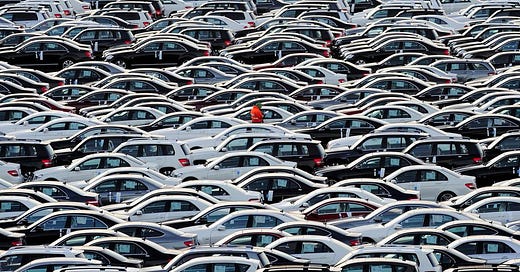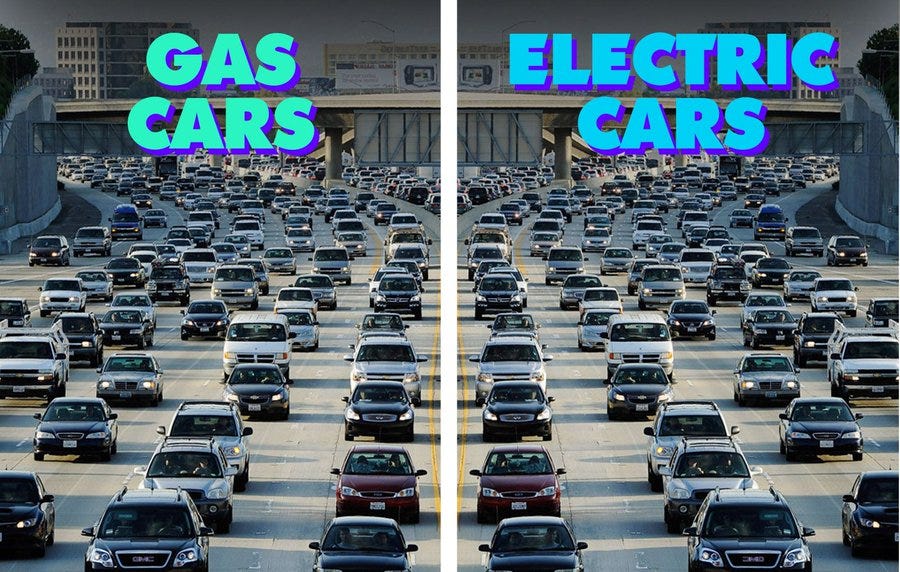It’s something that almost everybody is willing to accept, a statement that’s about as controversial as “The Rent Is Too Damn High.” There are too many cars on the road. As we all know, they cause pollution and sprawl, and kill people. They also lead to congestion, which makes you late for work, school, or the doctor’s appointment. (Remember, though, you aren’t stuck in traffic—you are traffic.) We, and the planet, would be better off if there were fewer cars on the road, and more people could get around by transit, bicycle, wheelchair, or by foot. And, intellectually at least, people seem to understand the link between tailpipe emissions and global heating.
This summer, temperature records around the world are being shattered. The megadrought in the American southwest is being reclassified as full-on desertification. Last week, the historic capital of Hawaii was incinerated, and a hundred-plus lives lost, thanks to an unheard-of combination of intense dry winds and high temperatures. As I write this, the entire population of Yellowknife is being evacuated, as vast swaths of the Northwest Territories are gripped by an unstoppable blaze of massive proportions. In the north of Quebec, in the James Bay region, dozens of wildfires are currently burning.
Yet when somebody dares to connect the dots, and point out that if we really want to reduce emissions, we might actually have to reduce the number of vehicles on the road—starting, like, yesterday—all hell breaks loose.
This happened in my corner of North America, the province of Quebec, when the minister of the economy and innovation Pierre Fitzgibbon dared to say the following at a press conference this week: “I’m one of those people who believes in electric vehicles…Everything should be electric! But there should be half as many of them.” (By “them,” he meant cars.)
The minister’s statement made headlines in the Journal de Montréal (our version of the New York Post), and had the minister’s spokesperson hastily declaring that the provincial government had no actual plans to reduce the number of vehicles on the roads of Quebec. The following day, premier François Legault further walked back Fitzgibbon’s words: “We have to be realistic…It’s not up to the government to say who will drive what. People will do what they want. Those who want three [cars] will get three.”
And, I have to hand it to the Journal, whose reporters love nothing more than calling out perceived hypocrisy: they managed to dig up a recent photo of Fitzgibbon, dressed in a leather jacket, posing next to a 2023 BMW K 1600 Bagger outside the dealership, which congratulated him on its social media feed for acquiring such a superb ride. The motorcycle in question is massive, with a “legendary” 6-cylinder engine that is definitely gas powered.
After you’re done chuckling, let’s drill down into the stats. There are currently 1.4 billion cars on the roads of the world. In spite of all the hype about EVs, only 26 million of those are electric. The term “motorization” is used by statisticians to describe the level of car ownership in a society, with 400 vehicles per 1,000 generally set as the threshold for “mass motorization.” Not surprisingly, the USA leads the world in motorization with 866 vehicles per 1,000, with Canada closer to 670, around the same rate as France, Germany, and other western European nations. In Quebec, which has a population of 8.45 million, there are an estimated 7 million registered vehicles, only 171,000 of which are electric. The provincial government’s line is that it’s aiming to have 2 million electric vehicles on the road by 2030—which is seven short years from now.
I’ve gone on the record as being extremely skeptical about a society-wide transition to electric vehicles. I think it’s just lazy, more-of-the-same thinking, a classic technofix that allows governments to swap one car for another (heavier, more costly) car, and one that does nothing to diminish sprawl, congestion, and road deaths. (Not to mention the fact that a billion-plus EVs would require masses of “white oil,” lithium, which comes from open-pit mines, often located on the land of already hard-pressed indigenous people.) There’s a classic meme (shown below) that captures the difference, from a city-dweller’s point of view, between a fleet of gas-powered cars and a fleet of EVs.
So what is Quebec, and its current government, the Coalition Avenir Québec, actually doing to achieve its goal of reducing greenhouse gas emissions? Not much. In its 2023 budget, 70% of transport investments went to highways, and only 30% to transit, with none allocated for inter-city transport. In the last decade, the number of standard-sized cars sold in Quebec decreased by 6%, while SUV sales increased by 112%.
And here’s the bottom line: from 1990 and 2017, the population of Quebec increased by 25%, while the number of cars on the road increased by 64%.1
Let’s be clear: the transport sector is now the leading contributor to climate change; in Quebec, it’s responsible for 43.3% of greenhouse gas emissions.
As Ogden Nash once said, “We’re making great progress. But it’s in the wrong direction.”
In other contexts, I’ve written about how so many people—in Canada, the United States, and the world—are constrained by land-use practices to rely on cars. For a few generations now, we’ve been building our cities, suburbs, and exurbs around automobile use. Opting out just isn’t an option for many people. Solving these problems is a multi-fronted, long-term project, one a few cities around the world have been working on for a while. But their work is made much harder by the fact that factories keep on cranking out new cars, most of them still gasoline-powered, and the rate of production isn’t declining.
That said, individuals have agency. Many of those who take the climate crisis seriously have rearranged their lives so they don’t have to rely on the vehicles that are driving global heating.
In this, the Summer from Hell, you have to be pretty obtuse not to make the connection between emissions and the wildfires, shattered heat records, and atmospheric rivers currently ravaging Canada, and the world. Yet when an elected official suggests that maybe, just maybe, we should think about reducing the number of greenhouse gas-emitting vehicles on the road, their statements are met with shock and outrage.
Of course, we live with this cognitive dissonance every day—and we’ve seem it in the Mad Max-style scenes of gas-powered vehicles fleeing a blazing Fort McMurray, and now a flame-menaced Yellowknife. The reaction to the minister’s modest proposal, however, is a particularly blatant example of this phenomenon at work.
It boils down to this: “Sure, there are too many cars in the world—but that doesn’t apply to me. Because I need my car.” Multiply that belief by 1.4 billion, and you get melting ice shields, floods and hurricanes, and a world in flames
Many of the above-cited statistics for Quebec can be found here.








Great piece, albeit an elaborated statement of the obvious. It's so dissonant that such a common sense position is one likely to provoke a multitude of attacks.
There's a huge disconnect between politicians who represent the will of their polity, and their consequently doing the right thing for the environment when in office: That won't win votes.
It's high time major economies set up Environmental Agencies bound by, say, the Paris accords, who act independent of Government, but with a writ to deliver environmental targets, just as Central Banks are disassociated with Government in order to best meet fiscal policy.
Both sets of goals are ratified by government. The pursuit of those cannot be limited by the whims and caprice of parliamentary terms of office.
Plainly, in what is correctly referred to here as 'The Summer from Hell,' the consequences of inaction are simply too dire. I fear this Summer from Hell is the first of many...
Just got back from visiting Boston where we did most of our sightseeing on foot. Lots of historic, walkable areas that are also desirable (and expensive) places to live. Maybe we need to focus on the carrot (would you like to love somewhere where there are lots of things to see and do, meaning you can access them daily?). I'm guessing there is a pretty huge market for affordable, walkable, safe communities.